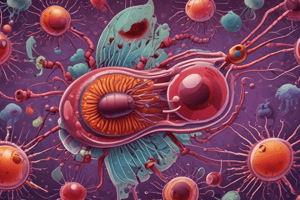Podcast
Questions and Answers
How many species of Plasmodium are known to infect humans?
How many species of Plasmodium are known to infect humans?
- 5 (correct)
- 20
- 10
- 3
What is the first stage of the Plasmodium life cycle?
What is the first stage of the Plasmodium life cycle?
- Sporogony (correct)
- Merozoite formation
- Exoerythrocytic schizogony
- Erythrocytic schizogony
What is the primary method of diagnosing malaria?
What is the primary method of diagnosing malaria?
- Blood transfusion
- Rapid diagnostic tests (RDTs)
- Microscopic examination of blood samples (correct)
- Physical examination
What is the primary host of Plasmodium?
What is the primary host of Plasmodium?
What is the main consequence of Plasmodium infection?
What is the main consequence of Plasmodium infection?
What is a common preventive measure against malaria?
What is a common preventive measure against malaria?
Study Notes
General Characteristics
- Plasmodium is a genus of parasitic protozoa that causes malaria in humans and other animals.
- There are over 200 species of Plasmodium, but only five are known to infect humans: P. falciparum, P. vivax, P. ovale, P. malariae, and P. knowlesi.
Life Cycle
- The life cycle of Plasmodium involves two hosts: a mosquito vector and a vertebrate host (human or animal).
- The cycle consists of three stages:
- Sporogony: The mosquito ingests infected blood, and the parasite develops into a sporozoite.
- Exoerythrocytic schizogony: The sporozoite infects the liver cells of the vertebrate host, where it multiplies and forms merozoites.
- Erythrocytic schizogony: The merozoites infect red blood cells, where they multiply and cause the cell to rupture, releasing more merozoites.
Pathogenesis
- Plasmodium infects red blood cells, leading to their destruction and the release of toxins.
- The infection causes a range of symptoms, including fever, chills, and flu-like symptoms.
- Complications can include anemia, cerebral malaria, and organ failure.
Diagnosis and Treatment
- Diagnosis is typically made through microscopic examination of blood samples or through rapid diagnostic tests (RDTs).
- Treatment usually involves antimalarial drugs, such as chloroquine, quinine, and artemisinin-based combinations.
- Preventive measures include using insecticide-treated bed nets, wearing protective clothing, and applying insect repellents.
General Characteristics
- Plasmodium is a genus of parasitic protozoa that causes malaria.
- There are over 200 species of Plasmodium, but only five infect humans: P.falciparum, P.vivax, P.ovale, P.malariae, and P.knowlesi.
Life Cycle
- The life cycle of Plasmodium involves two hosts: a mosquito vector and a vertebrate host (human or animal).
- The cycle consists of three stages:
- Sporogony: Mosquito ingests infected blood, and the parasite develops into a sporozoite.
- Exoerythrocytic schizogony: Sporozoite infects liver cells, multiplies, and forms merozoites.
- Erythrocytic schizogony: Merozoites infect red blood cells, multiply, and cause the cell to rupture, releasing more merozoites.
Pathogenesis
- Plasmodium infects and destroys red blood cells, releasing toxins.
- Symptoms include fever, chills, and flu-like symptoms.
- Complications can include anemia, cerebral malaria, and organ failure.
Diagnosis and Treatment
- Diagnosis is made through microscopic examination of blood samples or rapid diagnostic tests (RDTs).
- Treatment usually involves antimalarial drugs, such as chloroquine, quinine, and artemisinin-based combinations.
- Preventive measures include using insecticide-treated bed nets, wearing protective clothing, and applying insect repellents.
Studying That Suits You
Use AI to generate personalized quizzes and flashcards to suit your learning preferences.
Description
Learn about the characteristics and life cycle of Plasmodium, a genus of parasitic protozoa that causes malaria in humans and other animals.




